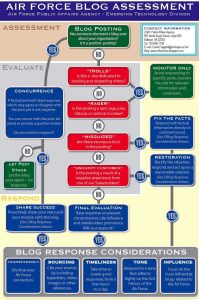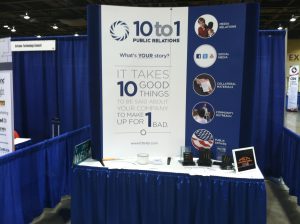It’s amazing how many companies fail to properly take full advantage of media opportunities that trade shows and conferences provide.
National or industry trade shows create an excellent opportunity to meet with key industry reporters since most national industry publications send reporters or editors to bigger conferences. Since the reporters are spread out across the nation, you’ll likely never have another opportunity to meet many of these reporters/editors outside of a conference setting. A short face-to-face meeting, even if it doesn’t result in an immediate story, will make all future story pitches significantly easier.
But here’s the catch— reporters don’t roam the show floor deciding what booth to stop at and interview the company. Reporters start scheduling all their appointments 30-60 days before the conference even begins. By the time the show begins, they are completely booked up. At big shows, reporters schedule 15 minutes blocks– even scheduling bathroom breaks. At the biggest shows, they even coordinate times and aisles so that they don’t have to walk from one side of the exhibit hall to the other constantly.
Here’s the key—as an exhibitor you need to ask your conference sales rep for the attending media list. You also need to ask for last year’s attendee list since some media formally sign-up late even though they know they are attending.
Two months before the conference, send an email to all the attending reporters (even last year’s attendees) requesting to schedule a short demo or conversation at your booth with the company owner. You’ll likely also need to call each reporter several times over a couple weeks to schedule. If a reporter from the previous year’s attendee list says they aren’t attending this year, ask who from their publication will be attending. That said, a lot of reporters attend the same conferences year-after-year.
You also need to ask if there’s a press room at the trade show. The press room usually isn’t publicized or open to the public, as it’s a refuge for media only. That said, you can leave press releases in the press room. You may also be able to schedule a press conference or demo in the press room.
If you have a new product or next version upcoming, you should also consider launching at the trade show. You can put out press releases prior to the event, or even do some paid advertising at the show or send postcards to conference attendees to promote the launch. The trade show gives you an opportunity to create some extra buzz. Plus it gives media an excuse to consider meeting with you at the conference or include you in planned show stories.
Don’t forget, use your social media to promote your booth before and during the event—and always include your booth number so people can find you.
You should approach local trade shows, like those hosted by a local Chamber of Commerce, very differently. These shows are great for generating leads and building your brand, but there aren’t a lot of media opportunities at a local community trade show outside of the media that you can and should do every day.
General tips for Exhibiting:
Once you are exhibiting, here are some tips. Stand in front of the table, not behind it. As people walk buy make eye contact and say hello. Strike up a conversation when possible, but your goal should be lots of short conversations.
As you collect cards, write an “A, B or C” on the back once the person walks away. An “A” is for a hot lead, “B” for warm, and “C” is for an unlikely client. For “A’s” and “B’s” write a reminder of the conversation. Did you talk about sports, a specific business problem they are facing, etc.
Within 24-48 hours, send a personalized email thanking them for stopping by your booth. Your “C” cards can get a generic email and include a request that if they have friends or know of anyone that needs your service, to please refer you.
For “A’s” and “B’s” send a slightly more personalized email mentioning the discussion you had (the note you left on the card will remind you of the conversation). For “A’s” ask for a follow-up conversation by phone or in person to continue the conversation.
If you’re exhibiting at a trade show, you better get all you can out of it!


